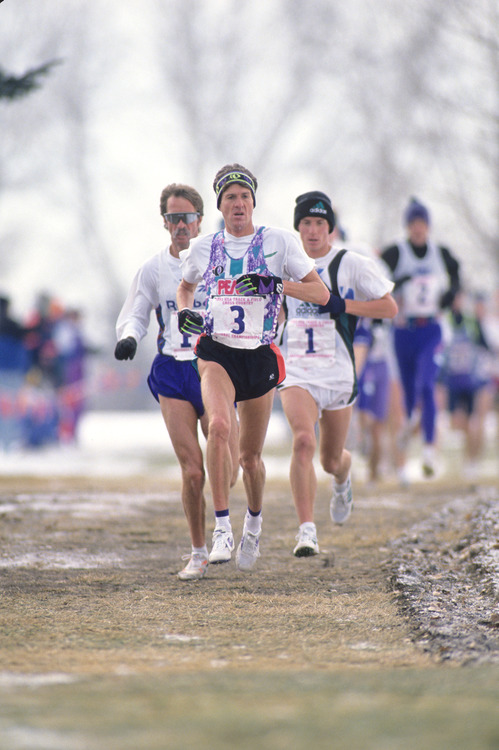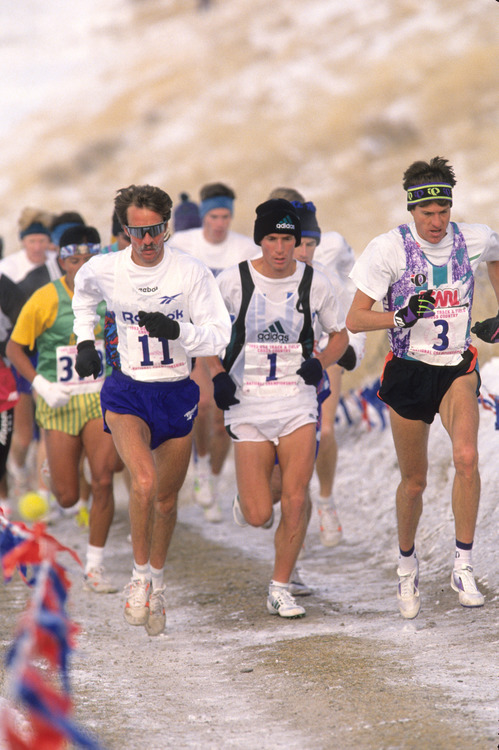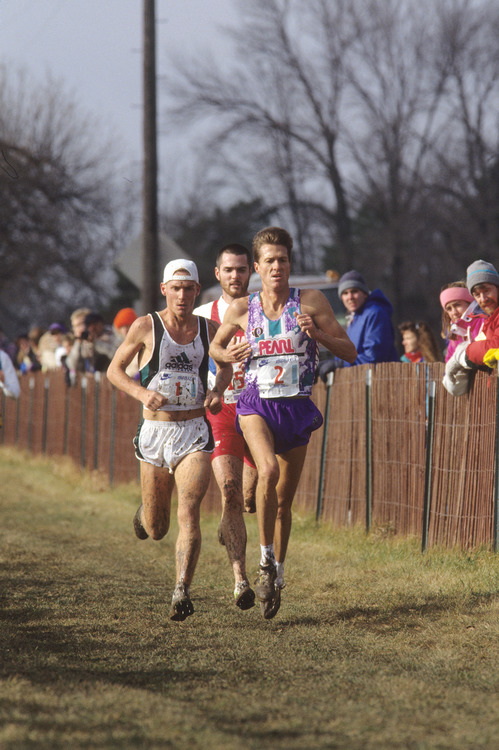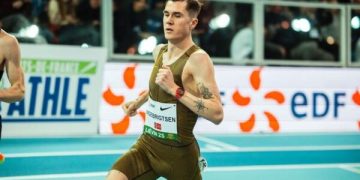He Wore Short Shorts, Just Like We All Did
RelatedPosts
Ed Eyestone, Todd Williams, Pat Porter, USA XC 1993,
photo by PhotoRun.net
U.S. cross country legend Pat Porter’s life, as told by those who ran with him
by Jon Gugala
On the morning of July 26, far from the excitement of the 2012 London Olympics,
a Beech B-60 airplane crashed just past the departure runway of a small airport in
Sedona, Ariz. Determined a “loss of lift” after takeoff, Pat Porter, a two-time
Olympian and the aircraft’s pilot, was killed, as was his 15-year-old son and
his son’s friend. Porter was 53.
Ed Eyestone, who was on the 1988 U.S. Olympic team with Porter and has remained in communication with him over the years, remembers receiving the news later that morning when checking emails. He remembers his disbelief, and the hope that the news wasn’t true. He remembers in one of their many telephone calls Porter inviting him to go for a flight sometime.
It was not in Seoul that the pair met; while Porter twice represented the
U.S. in the 10,000-meters (in 1984 and 1988), his legacy looms larger than
life over domestic cross country, where he won eight consecutive TAC
(the precursor to USA Track & Field) titles from 1982 to 1989. It was
in this arena, and in the mud and grass of the IAAF World Cross Country
Championships, that cemented a relationship that would last though
Porter’s early passing.
Simply put, no American has ever matched Porter’s cross country dominance,
and with the disrepair that it has fallen in both domestically and abroad,
it’s unlikely that anyone ever will. Even American legend Craig Virgin,
who won the 1980 and ’81 World Cross Country Championships and was a
nine-time world team competitor between 1978 and 1988, was not as
consistently great at the sport. Porter’s passing ended an era.
There are many things that made Porter great, but what teammates
remember first was his stride. Virgin, who was on five World Cross
teams with him, remembers Porter with legs too long to be utilized
on the track: “His stride was longer than normal and he was real
springy,” he says. “If we ran in the snow or the sand, he probably
had 12 or 14 more inches to his stride than I did. And he floated.
He was real light, real thin, real wiry, and just seemed to float
through the mud when we got to those European courses.”
Eyestone, who from 1983 World Cross in Gateshead, England, was
Porter’s roommate every year from then on, remembers stifling a
groan when it came time to squaring off with Porter at nationals:
“You knew that it was going to a long, grinding ordeal,” he says,
“and you knew you were probably going to end up watching his bony
stride rolling away from you.”
What differentiated Porter, Virgin says, was his relative speed,
which differed from track speed.
“In cross country, if you could run a 58- to 62-second last 400 [meters],
you were running pretty damn fast,” he says. “A lot of the big-time kickers
that could run 56 on the track couldn’t run a 58-60–they just weren’t built
that way. He probably had faster finishes, relatively speaking, on cross
country than what he had on the track.”
But that relative speed and tailor-made frame paled when compared to Porter’s
fanatical devotion to cross country. Add in that piece to the man, and you
begin to understand his myth.
Talking to former teammates and competitors, they unanimously agree that
no one took cross country more seriously, even though everyone in that
decade took it seriously. Virgin remembers Porter cutting European track
campaigns short in mid-July, with a month and a half left in the season,
so that he could start his preparations for cross. And Virgin remembers
thinking, if only Porter had stuck around longer in Europe, maybe he would
have learned the track tactics that would have led to his big breakthrough
in that medium. But Porter’s heart was on the grass.
“He was very intense on race day,” Eyestone says. “Any time you have a
guy that has won the national championship eight years in a row, there
are going to be some guys that aren’t huge Pat Porter fans. So I’m not
going to say that he didn’t have the swagger and the ego that went along
with that. But that’s not a bad thing. And that’s what made him a champion.
“I think a lot of people were looking at cross country as a preparatory
thing for the track season, but I think he realized he had a particular
gift to run up and down hills and through grass and mud. I think he felt
like it was a gift, so he was going to utilize it.”
Of his eight years running World Cross, Porter’s peak result was in 1984,
when he finished fourth in the horsetrack of the Meadowlands in New Jersey.
It was and is one of the two times the U.S. has hosted the race, and from the gun,
Porter dictated the pace. He led lap after lap, up and down the makeshift
plywood hill, until Carlos Lopes of Portugal put in a final surge in the
last loop of the course. Porter’s result, with Eyestone in sixth, led the
U.S. men to a second place team finish.
“We were second because we had such a strong team. And Pat Porter was the
epitome of that. He came in with an unmatched passion for it,” says Virgin,
who was 17th that year.
But, as with all things, “Our lives get busy,” Eyestone says,
“and we move on.”
Eyestone, after Olympic marathons in 1988 and 1992, is now the head track
and field and cross country coach at his alma mater, Brigham Young University,
and Virgin continues to work extensively in the running industry. When Porter
finished his career, from all accounts he quite simply left running behind.
“When I talk with other guys back from my era, most all of them enjoy talking
about back in the day. They enjoy talking about the old races, or the old workouts,
or the old rivalries, and laughing at each other,” Virgin says. “Pat visited with me,
and was very cordial on the phone, but I walked away from it with the impression that he had basically said, Ok, that’s over. That’s my other life. Now I’ve moved on.”
Todd Williams, Pat Porter, Bob Kennedy, USA XC 1992,
photo by PhotoRun.net
“He wasn’t one of these guys who was living in the past. I don’t know how many people really knew ‘The Olympian’ Pat Porter. He wasn’t even really worried about that,” Eyestone says.
Porter married 1988 Olympian Trish King, leaving his adopted hometown of Alamosa, Colo., to settle in Albuquerque, N.M., and raise a family. He became a top salesman for an area homebuilder and won a number of awards in recognition. Eyestone says that when they spoke, Porter seemed to have taken all the devotion and passion he had for the sport of running and turn it toward his family.
Eyestone remembers once at a World cross trip, he and Porter had one of those rare spiritual conversations that young, invincible men have. “I remember he asked me, ‘What’s your ultimate goal?’ he says. Here I said we believe if you believe in Christ and do good and try to live a decent life and serve others, we can ultimately return to live with God someday with our families forever. He said, ‘Well, that’s the same ultimate goal that I have, too.’
“We didn’t share the same religion, but we shared the same kind of belief
system. I thought of that discussion as I heard of his passing, and I thought
that, to me, it seems that Pat had done everything in his life for that to
come to pass.”
Virgin, when we talk, is doing one of his infamous late-night road trips from his
home in southern Illinois to Chicago, and he says that it’s been a long day.
“I just want to make sure that you understand that Pat was a tough competitor,
but he was also a good teammate,” he says. “Again, I’m tired. I’m starting to
blank out here on you.”
You can hear the road noise underneath his tires, and the sound of the windshield
wipers as they slap away the tail of a northbound Hurricane Isaac.
Is there anything else you’d say about Porter, any last memories of him as a teammate?
He and Eyestone have already told their Porter stories, how he used to keep rattlesnakes in glass tanks in his living room, or how he rode a Harley and collected guns, some automatic.
“I never saw Pat in western boots, and to this day I always wonder why,” Virgin says. “Of course he had that panther tattooed on his leg later on in his career. That made a big impression with the girls because it just sort of peeked out of his shorts.”
Virgin is quiet for a moment. Then he says, “Pat let his feet do that talking.
And he wore short shorts, just like we all did.”
Updated September 28, 2012
Updated October 9, 2012, with pictures from 1993, 1992, courtesy of PhotoRun.net.
Author

Larry Eder has had a 52-year involvement in the sport of athletics. Larry has experienced the sport as an athlete, coach, magazine publisher, and now, journalist and blogger. His first article, on Don Bowden, America's first sub-4 minute miler, was published in RW in 1983. Larry has published several magazines on athletics, from American Athletics to the U.S. version of Spikes magazine. He currently manages the content and marketing development of the RunningNetwork, The Shoe Addicts, and RunBlogRun. Of RunBlogRun, his daily pilgrimage with the sport, Larry says: "I have to admit, I love traveling to far away meets, writing about the sport I love, and the athletes I respect, for my readers at runblogrun.com, the most of anything I have ever done, except, maybe running itself." Also does some updates for BBC Sports at key events, which he truly enjoys. Theme song: Greg Allman, " I'm no Angel."
View all posts























